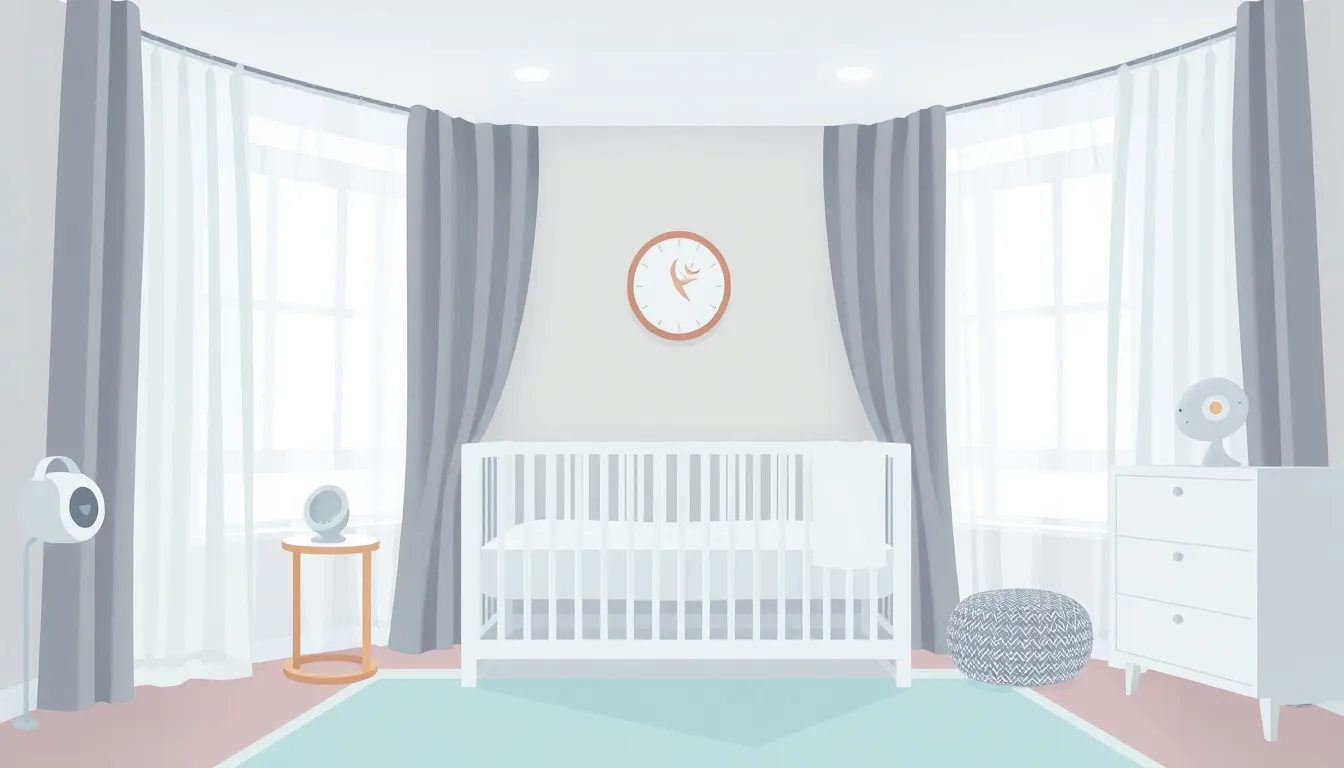Table of Contents
ToggleNewborns and sleep—it’s a match made in a sleep-deprived parent’s nightmare. Those tiny bundles of joy seem to have a superpower: staying awake when you desperately need a break. But fear not! With a sprinkle of patience and a dash of strategy, parents can unlock the secrets to better sleep for their little ones.
Understanding Newborn Sleep Patterns
Newborns exhibit unique sleep patterns that often bewilder parents. Recognizing these patterns fosters better sleep for both the baby and the caregivers.
The Science of Newborn Sleep
Newborns sleep approximately 14 to 17 hours each day, divided into short intervals. During the first few weeks, sleep occurs in cycles of about 50 minutes. Rapid eye movement, or REM sleep, constitutes a significant portion of a newborn’s slumber, promoting brain development. Parents notice their babies often awaken due to hunger or discomfort, not because they are ready to be awake. Gradually, sleep patterns shift as they grow, leading to longer stretches of sleep at night.
Common Myths About Newborn Sleep
Many myths surround newborn sleep that can mislead parents. One prevalent myth suggests that newborns should sleep through the night from the start, which is unrealistic. Another misconception is that a warm room equates to a safer sleep environment, while the ideal temperature is actually between 68 and 72 degrees Fahrenheit. Many believe that co-sleeping enhances sleep, yet it can increase the risk of accidental suffocation. Dispelling these myths aids parents in developing a more understanding and supportive approach to their newborn’s sleep needs.
Creating a Sleep-Friendly Environment

Creating a sleep-friendly environment significantly improves newborn sleep habits. Parents can establish a calming space that promotes better rest.
Ideal Room Conditions
Optimal room temperature ranges from 68°F to 72°F. Maintaining a dark environment helps signal nighttime to the baby. Consider using room-darkening curtains to reduce light during sleep. A white noise machine can mask household sounds, providing a soothing auditory backdrop. Limit the number of toys and decorations in the crib, reducing distractions. Regular cleaning also helps eliminate allergens that could disrupt sleep.
Choosing the Right Sleep Location
Placing the crib in a quiet area minimizes disruptions. Sleeping spaces should be away from windows to avoid drafts and street noises. The baby sleeps best in a separate space to encourage independent sleep habits. Ensure that the crib meets safety standards to prevent hazards. For some families, a co-sleeper may suit their needs, allowing proximity without the risks of full co-sleeping. Choosing a consistent location establishes a familiar sleep routine for the baby.
Establishing a Sleep Routine
Creating a sleep routine helps regulate an infant’s sleep pattern, making nights calmer for parents. Consistency plays a vital role in guiding newborns toward better sleep.
Timing and Consistency
Setting a specific sleep time encourages newborns to recognize when it’s time to rest. Establishing a bedtime routine signals to the baby that nighttime is approaching. Aim to put the baby down for sleep around the same time each evening. These patterns foster a sense of security and predictability. Parents might notice improvements in sleep duration as consistency takes effect. Incorporate gentle activities like bathing or reading right before sleep, helping signal relaxation. Keeping days bright and nights dim also reinforces the natural sleep-wake cycle.
Soothing Techniques
Utilizing soothing techniques eases the transition into sleep for newborns. Swaddling can provide comfort, making the baby feel secure and cozy. Gentle rocking or swinging movements often calm babies and promote relaxation. Soft melodies or white noise machines create a soothing auditory environment, masking sudden sounds. Pacifiers may also help babies self-soothe and fall asleep more easily. Parents should monitor the effectiveness of different techniques, adjusting as needed to meet their baby’s preferences. Understanding each baby’s unique responses will guide caregivers toward the most effective soothing strategies.
Managing Sleep Challenges
Managing sleep challenges involves understanding common issues and implementing effective strategies. Newborns may face difficulties such as colic and sleep regression.
Dealing with Colic and Gas
Colic, which affects 10% to 40% of infants, often leads to excessive crying and discomfort. Parents can relieve this by trying tummy time, which helps expel gas. Massage techniques may also ease discomfort; gentle strokes on the tummy can be effective. Burping the baby frequently during feedings reduces the risk of gas buildup. Experimenting with a soothing environment, including dim lights and white noise, provides comfort during crying episodes. Some infants respond well to warm baths, which may help relax them and promote sleep.
Addressing Sleep Regression
Sleep regression typically occurs at 4 months, 8 months, and 12 months. Infants may suddenly awaken more frequently and resist sleep. Parents should maintain consistency in routine; a regular bedtime and calming activities signal that it’s time to rest. Responding to a baby’s cries promptly can reassure them and promote quicker resettling. Implementing a nighttime ritual reinforces familiarity, which is crucial for easing transitions. Observing developmental milestones might explain changes; additional comfort during these periods can help manage nighttime awakenings.
Safe Sleep Practices
Safe sleep practices are essential for reducing risks and ensuring newborns get restful sleep. Following these guidelines can create a secure environment for infants.
Reducing the Risk of SIDS
Reducing the risk of Sudden Infant Death Syndrome (SIDS) is a top priority for parents. Placing newborns on their backs during sleep significantly lowers the risk. Keeping the crib free from soft bedding, toys, and bumpers promotes safety. Room-sharing without bed-sharing can provide proximity without the dangers associated with co-sleeping. Maintaining a smoke-free environment also contributes to a safer sleep space. Thoughtful monitoring of room temperature, ideally between 68°F and 72°F, can further enhance safety.
Safe Sleep Positions for Newborns
Safe sleep positions for newborns are crucial for healthy sleep patterns. Always placing infants on their backs ensures optimal safety and comfort. Babies should sleep on firm mattresses designed for cribs or bassinets to minimize risks. Side sleeping is not recommended, as it may increase the potential for rolling onto the stomach. Avoiding positioning aids or sleep positioners further enhances safety by preventing unintended movement. To help with comfort, parents can utilize swaddling techniques, being sure to keep the swaddle loose around the hips and legs.
Navigating the world of newborn sleep can be daunting for new parents. By understanding their baby’s unique sleep needs and establishing a supportive environment, parents can foster healthier sleep habits. It’s essential to remain patient and flexible as every baby is different. Embracing safe sleep practices and maintaining a consistent routine will not only benefit the baby but also provide much-needed peace of mind for parents. With the right strategies in place, restful nights can become a reality, allowing families to thrive during this precious time.







